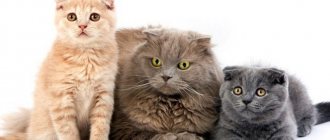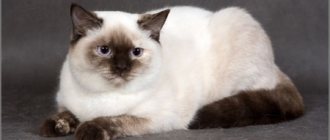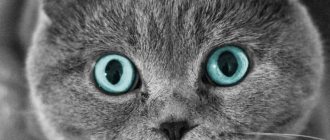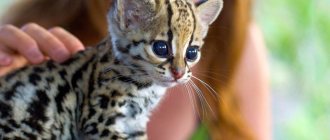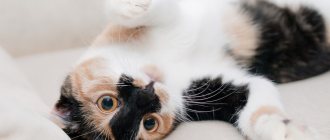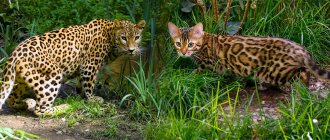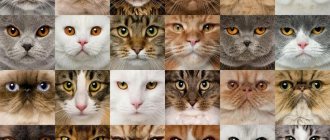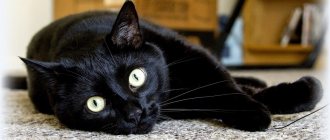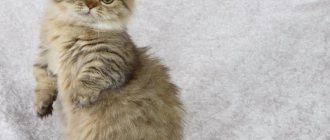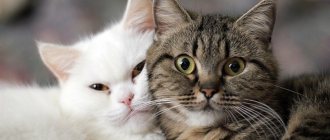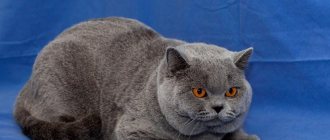Each breed of cat has its own calling card: Persians have long, thick hair, Munchkins have short legs, Maine Coons have an impressive size, not to mention the characteristic proud expression of their muzzle. But there are breeds that stand out not so much for the features of their structure as for the color of their coat.
Nature has endowed cats with a genome that allows them to have fur in a variety of shades: from red to golden, from pure blue to smoky white, from monochromatic to multi-colored. But even among such diversity, the rarest cat colors can be distinguished.
Cinnamon color
This color is literally translated from English as “cinnamon”. It has a reddish-brown tint, easily distinguishable from chocolate brown or cream. The nose and paw pads of cats of this color are pinkish-brown, while on their “dark” counterparts they are the same color as their fur or slightly darker. Cinnamon is not a variety of red or chocolate, it is a separate rare color that appeared as a result of the painstaking work of British felinologists. It is characteristic of this breed, but it is very difficult to obtain.
Lilac color
The lilac color is truly amazing: it is unusual to see an animal with pink-violet fur. Depending on the intensity, it is divided into isabella - the lightest, lavender - cooler, and lilac - a warm color with a slight “gray hair”. At the same time, the cat’s nose and paw pads have a similar, pale purple hue. Matching the color of the coat and these delicate areas of the body is considered a sign of a noble color. The British and, oddly enough, Oriental cats can boast of this.
Spotted color
Rare cat colors are not only monochromatic. When we think of spotted color, we immediately think of wild cats, such as leopards, manuls and other representatives of the cat family. But it can also be found in domestic Egyptian Mau and Bengal cats. This color is found in silver, bronze and smoky variations.
The Silver Mau has a light gray coat with a pattern of small dark circles. The skin around her eyes, mouth and nose is black. The main color of the Bronze Mau's coat is dark brown on the back and legs and creamy light on the belly. The body is decorated with brown patterns, and the face has ivory-colored skin. And the smoky Mau has an almost black coat with a silvery undercoat, on which there are almost no spots visible.
Tortoiseshell marbled color
Marble color, like tortoiseshell, is quite common. However, their combination is a rare phenomenon, moreover, it is characteristic only of cats; there are no cats of this color. An intricate pattern on a background of two colors looks unusual and very impressive.
It can also be blue, in which case there is a blue pattern on a warm beige background. There is also a chocolate marbled color. Such cats have red fur with richer “striations” of the same color and at the same time milk chocolate-colored fur with dark brown patterns.
Cat fur has an interesting feature. Not only rare colors, but also the most common ones appear only by 6 months, and in some breeds a rich color is formed only by one and a half years. Unscrupulous breeders like to take advantage of this, offering to buy an outbred kitten under the guise of a purebred and rare one. Remember: rare cat colors are obtained only from experienced felinologists who know their business well, do not skimp on their pets and devote a lot of time to them.
Nature has endowed cats with a genome that allows them to have fur of various shades - from red to lilac, from snow-white to chocolate - and variations: solid, smoky, marbled, tortoiseshell, point... But even among such diversity, the rarest cat colors can be distinguished.
Red Solid
In felinology, red is the red color and its variations - red marbled, red tabby (striped), red smoky, red color-point (acromelanic heat-dependent color in cats genetically related to the Thai and Siamese breeds), red solid (solid red), different variations of cream - “diluted” red.
It would seem that what a rarity is a red cat?
In fact, it is not so easy for breeders to get a purebred kitten of red color: it can only be guaranteed to be born from both parents of the same color. Of course, there is also chance, which professional breeders do not rely on.
The second caveat: it is almost impossible to see a solid red color without spots, light undercoat or stripes - at best, in cats of the “red solid” color, stripes on the paws and tail will still show through slightly and in certain lighting.
In addition, red color is very rare for females: among red whiskered cats, approximately 75% of cats and only about 25% of cats, and this is again due to the complex sex-dependent system of inheritance of the corresponding gene: a female kitten of red or cream color can only be born from such the same father and mother, who have red or cream colors in the genotype, and the coincidence of all these inputs is rare.
Chocolate
A beautiful, uniform dark brown color is truly rare for one simple reason: nature did not come up with a separate gene for it. The chocolate coat color is the result of a recessive condition of the black coat gene, in which eumelanin (the melanin responsible for black coat color) is oxidized, causing black to turn brown.
Due to the recessive nature of such a gene, it “works,” that is, is passed on to the offspring only if the second parent has exactly the same gene. That is why the iridescent chocolate coat is the privilege of purebred cats. Such a kitten can only appear in the litter of both chocolate parents - and even in this case there is no guarantee.
The color does not appear immediately: chocolate or not, it becomes clear only after a year and a half; the kitten can “overbloom” and have grayish, brown fur, as well as translucent stripes - tabby.
An adult chocolate cat should not have any white or other colored hairs, stripes or spots.
Lilac or lilac
Complex “solid” color, which combines shades of pink and blue, cream and gray, pale lilac and violets. Light, dark, deep, pearlescent - the variety of lilac colors is impressive.
Lilac color is found in British, Scottish, Carthusian cats, as well as Burmese - and they prefer warm rather than cold shades.
It is even more difficult to obtain lilac kittens than chocolate ones, because this requires a match in the parents not only of the recessive black genes responsible for the “chocolate” shade, but also the match of another pair of recessive diluent genes of this very “chocolate” - the lightening gene.
The lilac color is often confused with another also rare and “difficult to obtain” color - faun, or sandy, light beige. Sometimes you can distinguish a light lilac color from a faun by the pigmentation of the nose and paw pads: they are darker, with a lilac tint.
Faun and cinnamon
Deer, the color of a roe deer, the color of sea sand - there are many comparisons, but the meaning is the same. Faun is a very beautiful beige color. It should not be confused with cream - a highly diluted red.
Cinnamon literally means “cinnamon”.
Genetically, the “fawn” color is a highly bleached lilac, and the “cinnamon” color is a diluted chocolate color. They are inherited only if there is one parent of this color and the second is the carrier of the entire combination of recessive genes responsible for these colors.
To calculate the future "fawns" and "cinnamons", breeders make complex, almost mathematical calculations, carefully studying the genetics of the parents. Felinological systems, before issuing a document with a mark on such colors for each specific kitten, require a confirmatory genetic test.
Chinchilla
Contrary to popular misconception, the chinchilla is not a cat breed, but an amazingly rare color: the tip of each hair is ticked, that is, painted black. Due to this, the cat seems as if shrouded in a mysterious veil, and its fur shimmers and turns silver.
However, the silver chinchilla - with a pure white undercoat - is just one of the variations, although a very beautiful one. In addition to her, there are golden, blue, chocolate, lilac and cream chinchillas.
There are also many breeds in whose representatives you can find the chinchilla color: Persian, British, Scottish, exotic, Burmese and other cats.
The influence of genetics on cat color
There are two main colors responsible for variations in the colors of a cat’s fur coat:
Each color is formed due to a complex pigment - melanin, which is divided into two chemical subtypes:
- zumelanin (gene B) - is responsible for the black color and its derivatives;
- pheomelanin (gene A) - produces all shades of red.
The genes responsible for producing red (O - dominant) or black (o - recessive) offspring are located on the X chromosome. The color of a kitten's fur directly depends on the gender of the parents:
- cats have one X chromosome and one Y chromosome (XY);
- Cats have two X chromosomes (XX).
The kitten inherits one of the chromosomes from each parent. From the mother it will always be X, and from the father X or Y.
Just like in humans, female cats have a set of XX chromosomes, and males have XY chromosomes.
Two cat chromosomes (XX) are responsible for three basic colors:
- OO - red;
- oo - black;
- Oo - tortoiseshell (red-black).
The color of cats directly depends on which gene is carried by the only X chromosome of the parent - O or o. If there is an “O” gene on the only X chromosome of a cat, the cat will be red, but if there is an “o”, it will be black. Tortoiseshell cats appear only in the case of gene mutations and cannot have offspring.
If the parent X chromosome carries the O gene, the cat will be red, and if O, the cat will be black.
The white color stands out separately (although it is not a color at all, but rather its absence). If a cat is not an albino, then it is a carrier of some color.
Genetics of gray color
In felinology, the gray color of a cat's coat is called blue. In fact, the blue color is a bleached black. In gray pets, the dominant black gene B (Black) is diluted by the recessive light gene d. The black pigment (zumelanin), under the influence of the light gene, is not distributed evenly in the hair, but as if sticking together into lumps. The white spaces between the clumped zumelanin granules create a lightening effect. The less black pigment in the hair, the lighter the color of the cat.
Faun
Looks like lilac, but is actually a lightened version of cinnamon, or cinnamon color. It is found in Abyssinian cats and has a light beige tint that can be compared to coastal river sand. You can read more about it in our article “Fawn color in Abyssinian cats.”
Bengal cat
A graceful cat with a spectacular spotted color, called “rosette on gold,” was bred in the USA in the second half of the last century. The first Bengals were very expensive, since the breed appeared as a result of interspecific crossing. Exotic Asian leopard cats, inhabitants of Southeast Asia, were used for breeding work.
Bengal cats made a splash at their first exhibitions, the number of their fans and breeders grew literally before our eyes. So now anyone can get a pet leopard without much harm to the family budget. And he will never regret the money spent: Bengals are sociable, smart, affectionate, and not difficult to care for.
British shorthair cats ocarasa cinnamon
Cinnamon, or literally translated “cinnamon,” is an unusual spicy shade of cat fur. This coloring was not obtained by chance, but by the method of long and painstaking work of felinologists who studied the “British”. The result was a completely unusual color: reddish-brown, soft, pleasant.
At the same time, not only the fur received an unusual color, but also the nose and paws of the animal - not dark, as is usually characteristic of this breed, but light, soft pink.
What determines the color of a cat?
The color of the fur and coat, as well as the iris of the eyes, is due to the presence of a specific pigment - melanin. It is located in the cellular structures of the hair, resembling microgranules, different not only in shape, but also in size and quantity. This determines the different colors in cats.
In nature, there are several varieties of melanin pigment – eumelanin and pheomelanin. The first type of pigment forms spherical granules that have the ability to absorb all light and give a black appearance of the pigment due to oxidative processes. Pheomelanin forms elongated granules that have the ability to reflect light, transforming it into a red-orange spectrum of colors.
The type of melanin, eumelanin, affects the black coat color. Derivative colors are also obtained when eumelanin predominates - chocolate, blue, lilac and cinnamon. Pheomelanin is responsible for cream and red colors. The gene responsible for the appearance of red color, designated as O (Orange) or black (not Orange), is located on the X chromosome. This means that color depends on gender. Basically, cats have two X chromosomes, which is responsible for 3 color options - red, black or tortoiseshell (OO, oo, Oo, respectively).
Males have one X chromosome in their genetic code and the other Y, so depending on which allele the female chromosome carries, the future color of the kitten will be determined. Males are rarely tortoiseshell in color. Tricolor cats do occur, but, as a rule, this indicates disturbances in the genetic material. Such males cannot have further offspring. It has also been proven that a red male cannot be born to a black cat, and a red cat cannot give birth to a black kitten.
Cream
The cream color, which is the result of a dilution of the red gene, is found in a wide variety of varieties, from completely cream tabby cats to color-point beauties. It looks great on both short and long hair, and when the rays of the sun fall on an animal wearing such a coat, it appears pink.
Sometimes cream tabby cats are found in free populations, where there are many animals of red, in common parlance, ginger color.
Korat
Korat is a cat with a charming blue coat and olive green eyes. The second name of this purr is Si-Sawat, as she is called in her homeland, Thailand. It was on those lands that ancient images from the 14th century were found, depicting these purring creatures.
In 1965, the breed reached a new level - official recognition by authoritative "cat" organizations in the USA.
The appearance of the cat is very captivating - the muzzle is heart-shaped, and the eyes stand out against the gray background of the fur, like two green lanterns. In general, Korats are small in size and do not weigh more than 5 kg. Gray-blue mustaches have excellent genetics. They are energetic, kind and affectionate towards other people and pets.
The cost of a korat depends on the pedigree and other characteristics. The color is of particular importance; the more shade of silver, the more expensive. The approximate cost of a small breed class purr is $500.
How is the breed determined?
There is a whole branch of zoology responsible for the physiology of cats and their breeds - felinology. In accordance with it, standards were determined by which a particular animal is classified as purebred or not. In kittens at an early age, colors may change. And only after the age of 6 months does the cat’s fur acquire a permanent shade. There are a number of primary characteristics by which professional breeders evaluate the breed of an animal.
- Length, coat color.
- Eye color.
- Ear and nose color.
- Paw pad color.
If at least one part of the body does not meet accepted standards, then this individual will most likely be rejected.
You might be interested in: Unusual cats.
Interesting fact: according to statistics, most often the most unusual colors are cats, not males.
These pets also have an undercoat, and it happens that it differs in color from the main shade. This point is also taken into account if the cat takes part in competitions and selective mating.
The best cat breeds
1. Outbred kittens.
Cats without a breed can produce completely unpredictable offspring, with very different characters, both purebred and mongrel cats. They can have a variety of colors, short or long legs, they can be fluffy or not very fluffy, they are different. However, outbred kittens have one thing in common: they are very friendly, do not show aggression and are not vindictive.
Cats of this breed are cheerful and love to play, in addition, they will not bother you with their “meows”, since they are not particularly “talkative”. These cats adapt well to new environments and easily “find a common language” with children and other animals. Their fur is quite large, more like fluff, so sometimes you have to clean carpets and furniture.
3. American Curl.
Cats of this breed are distinguished by their unusual ears. Their color may be different, but the ears always remain of an unusual shape. They have a silky, medium fluffy coat. These cats are very gentle and good-natured. They show aggression extremely rarely and do not hold grudges.
Children love these fluffies that they can cuddle without worrying about their finger. These cats are calm and self-confident, and their patient and kind nature makes them quite lazy (they are inactive). They can make friends with a dog or other pet. Their coat does not require special care. Cats are susceptible to diseases, so it is worth monitoring their health, protecting them from diseases.
5. Abyssinian cat.
These cats are very active, like small children. They are very inquisitive and stick their noses everywhere. We do not recommend purchasing this kitten for small children, as it loves to be treated with respect and can scratch. The coat is short and does not require special care.
6. The Burmese cat is an excellent “nanny” from the feline family.
These cats have unusual patience and do not show aggression at all. They are very active and inquisitive, but not overly so, so you don't have to worry. They only meow for business. Their coat is short and does not require special care.
York chocolate cat: rules for keeping a purebred kitten and care
- Grooming.
Since the York Chocolate Cat is the proud owner of a thick, long coat, it requires more serious care. In order for your pet’s fur to always look chic and well-groomed, it needs to be combed, and one procedure once a week will not be enough. The optimal frequency of brushing a York cat is approximately three to four times a week, and during the shedding period this procedure should be carried out daily, or even better, twice a day. To do this, it is best to use a medium-hard massage brush with medium-frequency teeth. Beauty is beauty, but do not forget that this is necessary, firstly, for the health of your four-legged friend, and, secondly, for the cleanliness of your home. If you do not rid your cat of dead hairs in time, then half of them will be on all surfaces of your home, and the other, predominant part will be in the animal’s stomach, which can lead to a lot of problems. But even if you scratch your cat three times a day, she will still have fur in her gastrointestinal tract and this needs to be dealt with. If your pet is on lawns, he can find the right “healing potion” for himself, but if not, then you need to make him such a “lawn” at home. For this purpose, pet stores sell seeds of a special grass that is good at removing fur from a cat’s stomach. In addition, you can periodically feed the purr with special vitamins for hair removal or food to which special substances are added. As for bathing, the Yorkie chocolate cat cannot be called an ardent fan of water, so you should not expose it to stress again. The cat needs to be bathed; if this cannot be avoided, it is optimal to do this once a season using high-quality shampoo. Air conditioning will also come in handy. - Hygiene.
York Chocolate Cat is very clean, but he cannot cope with some tasks without your help. Once a week they need to clean the external auditory canal, as a large amount of earwax, dust particles and dead epidermis can accumulate there. If this is not done, then these products clog the ear canal and little by little the animal develops hearing loss, which can lead to total hearing loss. Cats need to have their teeth brushed, as plaque very quickly turns into tartar, which leads to dental disease and tooth loss, which significantly worsens the quality of life of your pet. To carry out this procedure, you need to arm yourself with a special toothbrush and a cleaning agent, this can be either cat toothpaste or powder. When brushing your teeth, it is recommended to carefully clean your gums, but this is extremely difficult to do with a brush. In this case, you need to wrap a piece of thick, clean cloth (lint-free) around your index finger and thoroughly clean the cat’s oral cavity. Animals must be taught all hygiene procedures from early childhood, so they will not experience so much stress. - What to feed?
Yorkie Chocolate cats are not picky when it comes to food, so the choice is yours. If the food is purchased, then it should be of high quality, premium or super premium; it is better to combine dry food and canned food. Natural homemade food consists of lean meats, offal, chicken eggs, dairy products, cereals and vegetables. Fish is strictly prohibited. From time to time you need to add additional vitamin and mineral complexes to your home diet. Clean drinking water should also always be freely available for York Chocolate Cat, the main thing is not to give the cat raw water - either boiled or filtered.
Plain (solid, solid)
The monochrome uniform coloring of Scottish cats is considered classic by breeders. The solid or solid color of the animal implies the absolute exclusion of any inclusions, small marks and specks of a different color. The tone is rich, even along the entire length of the coat.
The most common used to be considered blue plain Scots. But today among the representatives of the breed there are many other variants of solid colors.
White
A Scottish cat with snow-white fur (without yellowness) looks luxurious. Possible eye colors are blue, amber, copper. According to the standard, eyes of different colors are allowed. The paw pads and nose are light pink.
Kittens may have markings of a different shade, which disappear after the first coat change. By the age of two, the coat of a white Scot should be crystal clear, without spots of a different color.
Black
The black cat has expressive yellow eyes. The nose and paw pads practically blend into the main color of the animal.
On the shiny bright coat of the Scottish beauty Ebony, 2-3 hairs of contrasting white color are allowed. The presence of large red or brown marks is not provided for by the standard.
Chocolate
The brown Scottish cat, also called chocolate, looks noble and impressive. The color of the coat contrasts with the animal's yellow, golden or copper eyes. The nose and paw pads are also dark brown.
Lilac (lavender)
The monochromatic lilac Scottish Fold has a gentle gray tint that smoothly turns into cream. The nose is slightly brownish, the paws on the bottom are the same color as the coat, in harmony with the main color of the pet. This lilac-lavender color goes well with eyes of copper, amber or orange shades.
Red (red)
Red or ginger color is a rare and valuable color of the Scots breed. The fiery edge is combined with burning amber irises. Pads and nose to match the dominant color.
The tail of kittens and adult animals is not very evenly colored. This deficiency does not disappear with age and is allowed by the standard. And the presence of marks on the head and limbs that remain after reaching the age of two are considered a deviation from the norm.
A red Scottish straight-eared cat can give birth to kittens not only with erect ears, but also with ears pressed to the head.
Cream
The cream or peach fold cat is infinitely elegant and beautiful. The delicate background of light fur, bright golden eyes and a pinkish nose give the pet an irresistible appearance. The pads on the paws are also pink. An animal with this color is similar to a red Scotsman, but its coat color is a shade lighter.
A peach fold kitten may have a blurry, fuzzy pattern on its paws and tail that does not disappear with age. This is not critical for a purebred pet, but leopard markings are absolutely unacceptable.
Faun (deer)
There is another unique color of Scottish fold cats with an interesting name - fawn, which means “young deer”. The nose and pads on the paws of these beauties are beige-pink.
Cinnamon
Cinnamon is a lighter and more delicate color than chocolate, but darker than red. The nose and paw pads of such animals are brown, beige or pink.
Blue color (blue)
The gray or blue Scottish cat has very beautiful amber eyes. The coat tone of a purebred pet can belong to any range of gray - from the lightest (blue) to completely dark (blue). At the same time, each hair is saturated and well colored, without streaks.
The nose and pads practically do not differ in color from the plain coat.
A gray Scottish Straight cat may be marked with a few streaks and drawings in childhood. But as they grow older, these color flaws go away.
Solid animal colors
Monochromatic cats have everything painted the same color. The tone of the villi does not change along the entire length. There should not be a single spot of a different color on the body. There are pure colors:
- white;
- blue;
- black;
- chocolate;
- cinnamon;
- red;
- cream;
- faun;
- lilac.
White can hardly be called a color because it is a complete lack of pigmentation. Unlike birds and other animals, there are very few albinos among pure white cats. This is a normal color for Kao-mani with different eyes, Russian and Turkish Angora, white long-haired Scottish. If a cat has a thin stripe of a different color around its nose, then its color is considered “white.” The nose, paw pads and ears are pink. The eyes are light, they can be different, like Kao-mani's, one is yellow, the other is blue. White fuzzies with blue eyes have a gene mutation and may be deaf. Such defects are not observed in animals with other coat colors.
A white Angora cat is born with a small patch of color, mostly black. By 6 months, the kitten is completely white, all the dark fur is gone. But the kitten born to Angora is pure white and is an albino.
Snow-white Angora cat
A typical representative of blue cats is the Russian Blue. One of the most beautiful cat breeds. The gray cat has large green eyes and blue-tinged fur. The thick coat is the same from the nose to the tip of the tail. Green eyes and a gray nose, a long mustache give the impression of curiosity and bewilderment.
A gray cat of the British Shorthair breed has round yellow eyes, the inside of the ears do not reflect light skin.
Photos of black cats make a special impression. Graceful and mysterious, with yellow and brown eyes. The purebred black cat is found among the British and Bombay cats. They have dark noses and paw pads. Domestic outbred cats most often have a small white spot on their chest or socks on their paws.
A black cat has a dark nose and paws
A black cat with a light nose and paw pads is not a pure color, he just has dark fur. Despite numerous signs that such animals bring bad luck, in fact this is a very affectionate animal. No one is surprised by a black cat, the photo of which was taken with chickens basking under her or hedgehogs taken under her care.
Chocolate coat color is obtained when red pigment is added to black. The nose is also a warm brown color. The eyes are dark yellow, orange and brown. Active and curious animals. Chocolate colors are common among the following breeds:
- Burmese;
- exotics;
- Scottish;
- York
The light chocolate color is called cinnamon. It has a little more red and the animals look lighter. The nose is dark pink or light brown, the eyes are yellow, or may be blue. In addition to the British, the cinnamon color is characteristic of Scottish breeds and Orientals.
Cinnamon color shade
The red color is usually called dark red. Depending on the breed, the coat has different lengths. The noses are cream and light brown. The eyes can be different, it all depends on the breed. The British Shorthair has a long muzzle with an expression of curiosity and kindness. The Persians and Abyssinians seem to be dissatisfied with something all the time. In fact, the animals are calm and peaceful, they love to be in their house. The ginger cat is not afraid of water more often than others and even loves to swim.
Persians are more likely than other cats to have a cream-colored coat. Pastel fur coat and round copper eyes. The nose and paw pads are pink or cream. Among the British and Scots, this color is considered the norm, but it is rare.
The lavender color was artificially bred from the chocolate color by altering genes. On the color chart it is called light lavender grey. The noses are the same, but of a darker tone. Lavender color is rare in cats, these are short-haired British, lop-eared Scottish and long-eared sad Orientals.
Lavender color is artificially bred
Brilliant Californian
Brilliant California cats were bred by breeders as a result of numerous crossings of various pedigree cats. For 10 years, experts have been trying to get a pet that is visually similar to the royal cheetah, but without the admixture of wild blood, so for crossing they used only domestic cats of the American Shorthair, Angora, Siamese, British and Abyssinian breeds. The desired result was achieved in the 80s and the new cat breed was officially registered in the USA.
The appearance of the shiny Californian cats is as follows:
- large, muscular build;
- short, thick coat;
- large, slightly slanted eyes;
- small ears, rounded at the tips;
- elongated tail, dark at the end.
For shiny Californian cats, only one coat color is allowed, resembling leopard or jaguar. Cats of this breed are very sociable, active and good-natured. They treat strangers calmly and get along well with small children and other pets. An active pet needs long walks in the fresh air.
Signs and superstitions
Cats have always been surrounded by a veil of mystery and mysticism. From time immemorial they were considered guides to the other world and were often accused of aiding sorcerers and witches. Therefore, it is not at all surprising that such unusual, rarely seen animals with a tortoiseshell color are considered mystical. There are many signs and superstitions in different countries, but they all have one thing in common - a cat with a tortoiseshell color is a symbol of good luck:
England. In this country, it is not customary to just give a tortoiseshell cat as a symbol of good luck and happiness. You must definitely give at least a small change for it, thus paying for further success, peace and love in the house. If a kitten with an unusual color comes into the house on its own, you also have to pay for happiness
At the intersection of 4 roads you need to put coins: it doesn’t matter what the amount is.
Russia. In this country, any cat, regardless of breed and coat color, brought happiness and peace to the house
In Ancient Rus', cats protected the house from evil spirits, protected from evil spirits and enemies. It was especially good if the color of the animal’s fur matched the color of the owner’s hair. Then peace, comfort and love always reigned in the house, and good luck favored the household. In this regard, tricolor cats were considered universal. There are so many shades combined in the color of their coat that they will suit any hair color.
Japan. In this country, cats are respected and loved by everyone, and animals with a tortoiseshell color are revered with greater honor. Figures with their image are placed near the entrance to each house, hoping that they will bring good luck. The Japanese prefer to have bobtails as pets, relying on the tortoiseshell color, because they protect the house and protect household members from evil spirits and bad thoughts of enemies.
Important Note
If you want to get a cat of a rare color, remember: the fur of kittens changes after birth. You can understand what shade a cat will be only after six months, and sometimes even after a year and a half.
Therefore, when buying a small kitten, you do not yet see its color in all its glory. Sometimes this becomes a reason for fraud by unscrupulous breeders. Therefore, buy kittens only from professional nurseries.
Experienced breeders will be more likely to predict what the color of an adult individual will be, and you can really become the owner of a cat that is rare in color.
Red devils and timid white angels
No matter how strange it may sound, there is an opinion that the character of a cat is in some mysterious way connected with its color. Moreover, even some breeders and veterinarians think so, that is, people who, by definition, deal with a large number of these same cats.
Table: the estimated character of a cat depending on its color
| Cat color | Character |
| Black and white, gray, black tabby | Stress-resistant, the best possible |
| Calico | Demanding, independent, dedicated |
| White (with blue eyes) | Timid |
| Colorpoint with brown marks | Quite aggressive |
| Ginger | Brash, capricious, vindictive |
| Silver and brown spotted tabby | Nightmarish beyond description |
| Classic brown tabby or mackerel | Affectionate, flexible, playful |
| Blue (tabby or solid) | Friendly, contactable |
Ordinary cat lovers also notice some patterns.
The life of the author of this article at different periods of time was also connected with cats: a chocolate-point Siamese, a black-and-white bicolor of “noble” blood, and a Canadian Sphynx. And this is what the author has to say about this:
- Siamese was pure evil, an absolute misanthrope and an extreme dirty trick; he devoted his entire life to a fiery struggle to reduce the human population in a single apartment (and would still have achieved success if the duration of a cat’s life had not been significantly less than the duration of a human life);
- the black and white mongrel cat had a remarkably affectionate and devoted character and manners of a true gentleman: from the moment when True Love happened in his life, there was no such tasty treat that he would not take to the lady of his heart;
— the sphinx is a completely different story; It was this animal that cared so sincerely and openly about its owners that it did not consider it necessary to reveal its character to them at all.
However, even having two matches with the table out of three possible, the author will refrain from generalizations, since he is absolutely sure that assessing the character of a cat by its color is as futile as assessing the mental abilities of a woman by the color of her hair.
History of domestication of cats
The history of relations between humans and cats goes back several thousand years. Ancient chronicles and archaeological finds testify to this amazing neighborhood.
For a long period, scientists believed that the first who managed to domesticate cats were the ancient Egyptians. This conclusion was made after studying one tomb, which was built in 1950 BC. There were corresponding images on the wall paintings. However, studies of Cypriot burials in 2004 refuted these claims. The tomb, which dates back to about 9,500 BC, contained the remains of a man and a cat.
In ancient Egypt, these animals were given special attention. They were treasured because they helped people get rid of mouse infestations.
The Egyptians considered cats to be sacred animals. In the Middle Ages, attitudes towards them were ambiguous: in some countries cats symbolized kindness and tranquility in the home, while in others they were credited with magical properties and connections with evil spirits. Animals were especially widespread in some countries of Europe and North Africa, as well as in Russia, Japan and China.
In those ancient times, people did not attach much importance to cat breeds. This concept came into use about 200 years ago, when the rapid development of such a science as selection began.
On the territory of modern Russia, yard cats and cats appeared during the formation of Ancient Rus'. The breeding of purebred groups began only in the second half of the 18th century. In those years, the most popular breed was considered the Russian Blue, presumably bred in Great Britain.
